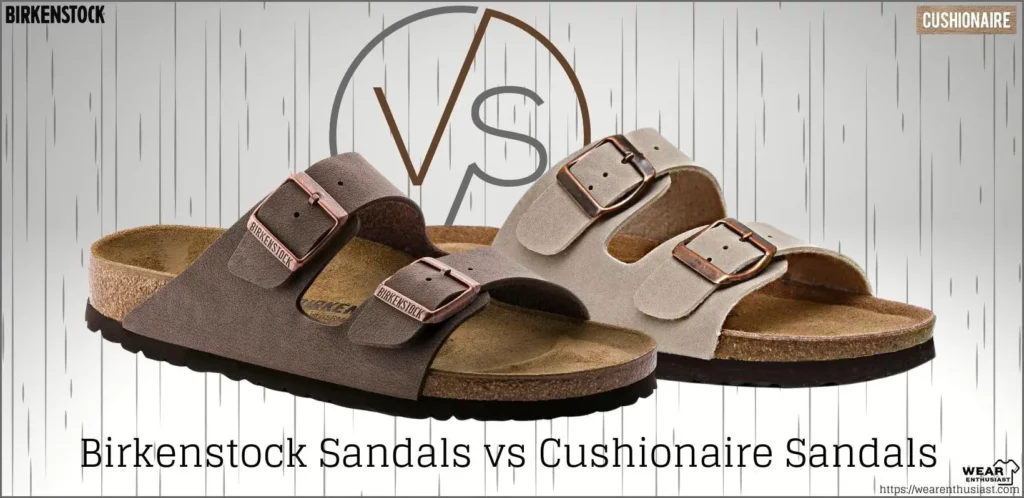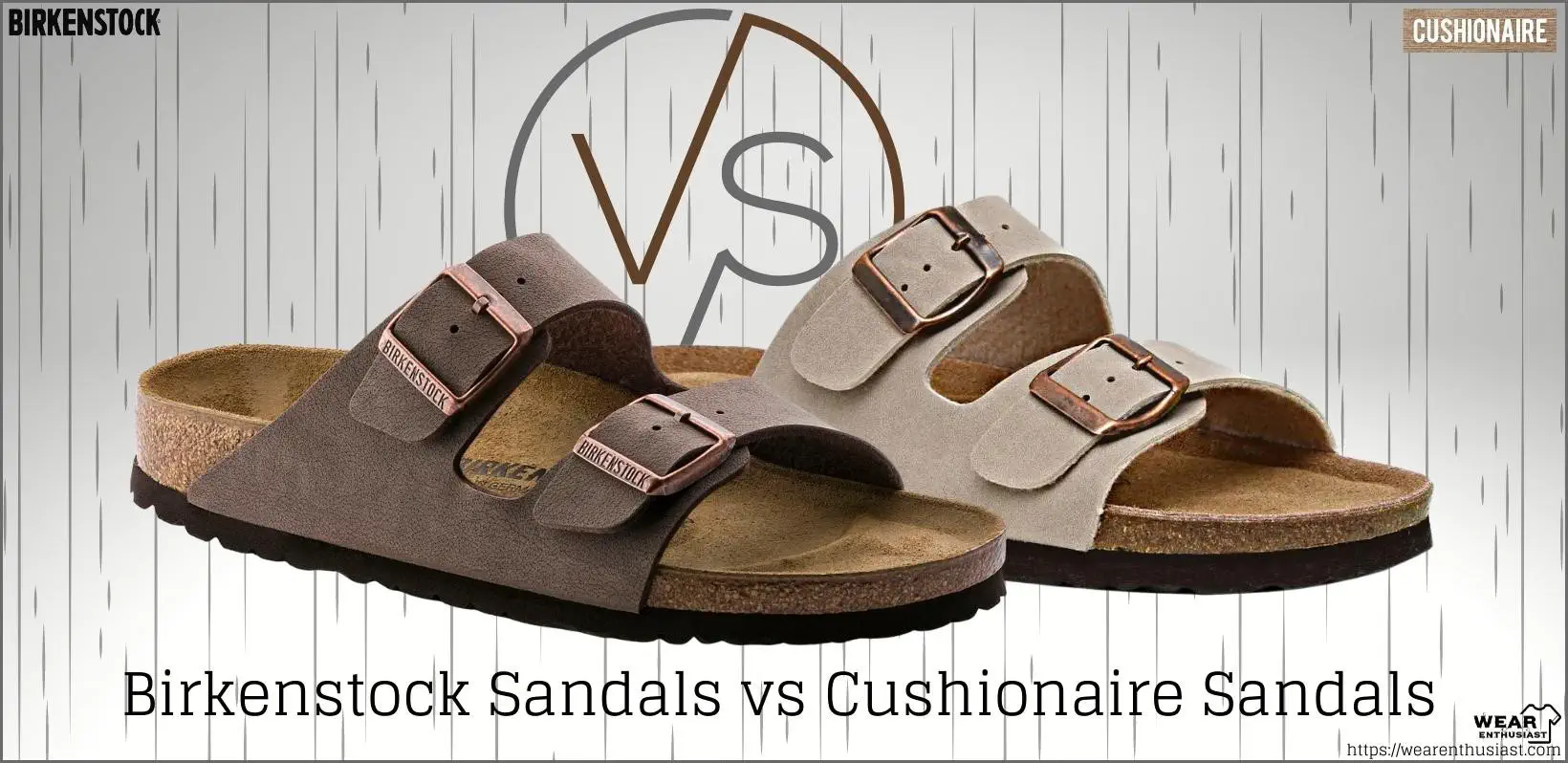
A new pair of sandals is on your wish list for summer. You’ve narrowed it down to Birkenstocks and Cushionaires, but you’re not sure which the best choice is. Both brands are popular, but they have different styles and features.
Birkenstock sandals are made with high-quality materials and construction. They’re designed for comfort and support, and they have a contoured footbed that fits your foot perfectly.
Cushionaire sandals also have a contoured footbed, but they’re softer and more cushioned than Birkenstocks. They’re made with breathable materials and have a lightweight design.
Let’s talk about more differences between Birkenstocks and Cushionaire sandals.
✤ How Do Birkenstock vs Cushionaire Sandals Differ?
Sandals are a summer staple, and they can last for years with the proper care. While both Birkenstock and Cushionaire footwear brands are loved for their comfort levels, there are several key ways in which these two brands differ:
1. Material of Construction
In order to manufacture the original BIRKENSTOCK footbed, natural materials from renewable sources are joined together in an elaborate production process. The top layer is made of suede, which is soft and comfortable against the skin.
Underneath the suede, there is a layer of natural cork, which helps to mold the footbed to the shape of your foot. Finally, the bottom layer is made of natural latex, which provides cushioning and support. The latex is also durable and long-lasting, making it an ideal material for use in footwear.
Cushionaire sandals are made of a number of different materials. Footbeds are curved to provide arch support, as well as being made of shock-absorbing cork.
A breathable mesh material covers the upper part of the sandal, keeping the foot cool and comfortable. The sole is made of durable rubber material, which provides grip and traction. Overall, the Cushionaire sandal is a well-constructed shoe that is designed for comfort and durability.
2. Level of Support
When it comes to supporting, Birkenstock sandals are tough to beat. Their signature cork footbed conforms to the shape of your feet over time, providing anatomically-correct support that helps to reduce fatigue.
Cushionaire sandals also feature contoured footbeds, but they’re not as flexible as Birkenstocks. As a result, they may not provide the same level of support for people with high arches or wide feet.
You can also check our article, Woodstock Sandals vs Birkenstock.
3. Ventilation and Breathability
In particular, Birkenstock and Cushionaire sandals have different designs when it comes to ventilation and breathability. Birkenstock sandals have a more open design, with straps that allow air to circulate around the foot. This can help to keep feet cool and dry, even in hot weather.
Conversely, Cushionaires have closed toes. This can provide more support and protection for the foot, but it can also cause the feet to become overheated in warm weather. For those looking for a cooler, more breathable sandal, Birkenstock sandals may be a better choice.
4. Weight and Feel on the Feet
Birkenstocks are made with a contoured footbed that fits your foot, providing exceptional support. Compared to Cushionaire sandals, they’re heavier as well, making them more comfortable to wear for long periods of time.
Some people prefer Cushionaire sandals because they have softer, more flexible footbeds that provide a better “hug” for the foot. They’re also lighter in weight, making them ideal for rainy days or hot summer days when you don’t want extra weight on your feet.
5. Style Aesthetics
Both brands offer a wide range of styles and colors to choose from. When it comes to comfort, Birkenstocks are widely considered to be more comfortable than Cushionaires.
Birkenstock sandals have a contoured footbed that provides support for the entire foot, while Cushionaire sandals only have to cushion in the heel and toe area. You can also customize the fit of Birkenstock sandals by adjusting them.
6. All-Day Comfort
In terms of comfort, Birkenstocks have the edge. The brand’s signature contoured footbed provides support and alignment, while the soft leather upper conforms to the foot for a custom fit.
Cushionaire sandals are also comfortable, but they lack the same level of arch support and can feel a bit slippery on foot. Despite that, they are a good option for those who want a sandal that can be worn all day without breaking the bank.
7. Toe Box Room
The toe box is the area of the sandal that covers the toes. Birkenstocks have a roomier toe box than Cushionaire sandals, which some people find to be more comfortable.
Cushionaire sandals have a closed-toe design, making them feel constricting for those with wide feet or high arches. If you’re looking for a sandal with a more spacious toe box, Birkenstocks is a better option.
8. Advanced Features
Both brands offer a variety of features that are sure to please even the pickiest shopper. Birkenstocks advanced features include a curved footbed, adjustable straps, and soft leather upper.
Cushionaire sandals also have a few advanced features, including an oval-shaped footbed and cushioned heel. Despite this, they don’t have the same quality construction and adjustability as Birkenstocks.
✤ Do Cushionaire Sandals Have Arch Support?
Cushionaire sandals are designed with comfort in mind. The footbed is curved to provide support for the arch of the foot, and the cork material absorbs shocks to minimize stress on the feet.
In addition, the straps are adjustable to ensure a snug and comfortable fit. Cushionaire sandals provide excellent support and comfort, making them ideal for long days on your feet.
✤ Are Cushionaire Sandals Good for Walking?
Cushionaire sandals are getting high marks from reviewers who say they are perfect for walking, whether around the block or across town. One of the main reasons for the comfortable fit is the supportive insole that conforms to the foot’s natural shape.
Another plus is the soft, breathable upper that helps keep feet cool and dry. The sandals also have a wide toe box that allows plenty of room for toes to move and spread out, and reviewers say this provides even more comfort on long walks.
In addition, the sandals have a durable rubber outsole that provides good traction on a variety of surfaces. Overall, reviewers say Cushionaire sandals are well-made and incredibly comfortable, making them ideal for walking or any other activity.
✤ Why Do Podiatrists Recommend Birkenstocks?
Podiatrists often recommend Birkenstocks for their patients because they offer good shock absorption and support for the foot’s arch. The thick, cushioned sole of a Birkenstock helps to absorb impact and protect the foot from injuries.
The deep heel cup also provides arch support, helping to reduce fatigue and prevent pain. In addition, Birkenstocks are adjustable, so they can be customized to fit each individual’s feet.
This means that Birkenstocks can provide a comfortable and supportive fit for people of all sizes and shapes.
Conclusion
Birkenstocks are the better option if you’re looking for a comfortable, supportive, and customizable sandal. Cushionaire sandals are also a good choice for those on a budget, as they are less expensive than Birkenstocks.
Now that you know the difference between Birkenstocks and Cushionaire sandals, you can decide which sandal is right for you. Trying both brands before making your final decision is a good idea since comfort is subjective.
Whichever sandal you choose, you can be sure that you’re getting a quality product that will provide years of use.

